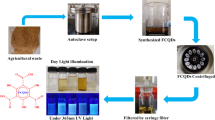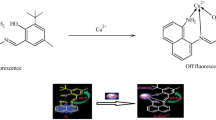Abstract
The receptor-bearing anthraquinone chromophore was synthesized by a simple aldamine condensation reaction, and its anion sensing properties were investigated via colorimetric, UV–vis, photoluminescence, and DFT calculations. The synthesized receptor detects both acetate and hypochlorite ions, where remarkable colorimetric transitions were observed from pink to purple for the acetate ion and pink to blue for the hypochlorite ion. Moreover, in the occurrence of the acetate ion, it shows an admirable answer for the Cr3+ ion, which changes its purple color to pink, while no notable change was observed for other ions. The detection limits of receptors with acetate and hypochlorite are 7.1 × 10–7 M and 9.4 × 10–7 M, respectively. The DFT calculation was performed to better understand the sensing mechanisms of both AcO− and ClO− ions. Furthermore, receptors were effectively utilized in the preparation of optical sensors supported by silica gel for the detection of AcO− and ClO− ions. The receptor proved itself to be potentially useful for real-life application by sensing AcO − in vinegar and ClO − ions in ala. Furthermore, its preeminent detection properties enabled the successful labeling of the AcO− ion in living biological cells.
























Similar content being viewed by others
Availability of Data and Materials
The data is available when its need.
References
Caltagirone C, Gale P (2009) Anion receptor chemistry: highlights from 2007. Chem Soc Rev 38:520–563
Gunnlaugsson T, Kruger PE, Jensen P (2005) Colorimetric “naked eye” sensing of anions in aqueous solution. J Org Chem 70:10875–10878
Nagai KJ, Maeda K, Takeyama Y (2005) Helicity induction and chiral amplification in a poly (phenylacetylene) bearing N, N-diisopropylaminomethyl groups with chiral acids in water. Macromolecules 38:5444–5451
Maeda H, Ito Y (2006) BF2 complex of fluorinated dipyrrolyldiketone: a new class of efficient receptor for acetate anions. Inorg Chem 45:8205–8210
Davenport A, Will FJ (1991) Hyperlactataemia and metabolic acidosis during haemofiltration using lactate-buffered fluids. Nephron 59:461–465
Schiff H, Lang SM, Konig A, Strasser T (1994) Biocompatible membranes in acute renal failure: prospective case-controlled study. Lancet 344:570–572
Shang XF, Xu XF (2009) The anion recognition properties of hydrazone derivatives containing anthracene. BioSystems 96:165–171
Singh NJ, Jun EJ (2007) Quinoxaline–imidazolium receptors for unique sensing of pyrophosphate and acetate by charge transfer. Org Lett 9:485–488
Hu SZ, Guo Y, Xua J (2008) A selective chromogenic molecular sensor for acetate anions in a mixed acetonitrile–water medium. Org Biomol Chem 6:2071–2075
Qiao YH, Lin H, Shao J (2008) A novel acetate selective UV–Vis chemosensor containing a tripodal benzaldehy dicphenylhydrazone. Chin J Chem 26:611–614
Wang YH, Lin H, Shao J (2008) A phenylhydrazone-based indole receptor for sensing acetate. Talanta 74:1122–1125
Bao XP, Yua JH, Zhou YH (2009) Selective colorimetric sensing for F− by a cleft-shaped anion receptor containing amide and hydroxyl as recognition units. Sensors and Actuators B: Chem 140:467–472
Shao J, Qiao YH, Lin H (2009) Rational design of novel benzimidazole-based sensor molecules that display positive and negative fluorescence responses to anions. J Fluoresc 19:183–188
Choi MK, Kim HN, Choi HJ (2008) Chiral anion recognition by color change utilizing thiourea, azophenol, and glucopyranosyl groups. Tetrahedron Lett 49:4522–4525
Ali HD, Kruge PE, Gunnlaugsson T (2008) Colorimetric ‘naked-eye’ and fluorescent sensors for anions based on amidourea functionalised 1, 8-naphthalimide structures: anion recognition via either deprotonation or hydrogen bonding in DMSO. New J Chem 32:1153–1161
March JG, Simonet BM (2007) A green method for the determination of hypochlorite in bleaching products based on its native absorbance. Talanta 73:232–236
Xie X, BinLi XC (2013) Study on a highly selective colorimetric chemosensor for Cu2+ detection and its indirect sensing for hypochlorite. Dyes and Pigm 98:422–427
Chang C, Wang F (2017) Benzothiazole-based fluorescent sensor for hypochlorite detection and its application for biological imaging. Sensors and Actuators B: Chem 243:22–28
Wang B, Chen D, Kambam S (2015) A highly specific fluorescent probe for hypochlorite based on fluorescein derivative and its endogenous imaging in living cells. Dyes and Pigm 120:22–29
Lin WY, Long LL, Chen BB (2009) A Ratiometric Fluorescent Probe for Hypochlorite Based on a Deoximation Reaction. Chem 15:2305–2309
Steinbeck MJ, Nesti LJ, Sharkey PF (2007) Myeloperoxidase and chlorinated peptides in osteoarthritis: potential biomarkers of the disease. J Orthop Res 9:1128–1135
Aoki T, Munemori M (1983) Continuous flow determination of free chlorine in water. Anal Chem 55:209–212
Kawai Y, Kiyokawa H, Kimura Y (2006) Hypochlorous Acid- Derived Modification of Phospholipids: Characterization of Aminophospholipids as Regulatory Molecules for Lipid Peroxidation. Biochemistry 45:14201–14211
Wang L, Li WX, Zhi W (2018) Rapid detection of hypochlorite by a coumarin-based hydrazide in aqueous solution and its application in live-cell imaging. Sensors and Actuators B: Chem 255:1112–1118
Kotas J, Stasicka Z (2000) Chromium occurrence in the environment and methods of its speciation. Environ Pollut 107:263–283
Zayed AM, Terry N (2003) Chromium in the environment: factors affecting biological remediation. Plant Soil 249:139–156
Gomez V, Callao MP (2006) Chromium determination and speciation since 2000. TrAC Trend Anal Chem 25:1006–1015
Wani A, Khan MS, Zaidi A (2008) Chromium-reducing and plant growth promoting Mesorhizobium improves chickpea growth in chromium-amended soil. Biotechnol Lett 30:159–163
Sun J, Ma L, Yang Z (2014) Optimization of species stability and inter conversion during the complexing reaction for chromium (speciation by high-performance liquid chromatography with inductively coupled plasma mass spectrometry. J Sep Sci 37:1944–1950
Pisarenko AN, Stanford BD (2010) Rapid detection of hypochlorite by a coumarin-based hydrazide in aqueous solution and its application in live-cell imaging. Anal Chim Acta 659:216–223
Gründler P, Holzapfel H (1971) Reaktionsstufen-coulometrie—II: Analytische untersuchung vonstoffgemischen. Talanta 18:147–153
Williams PM, Robertson KJ (1980) Determination of HCIO Plus ClO- by Bromination of Fluorescein. J Water Pollut Control Fed 52:2167–2173
Shao J, Lin H (2008) Study on acetate ion recognition and sensing in aqueous media using a novel and simple colorimetric sensor and its analytical application. Talanta 75:551–555
Wanga Z, Zhanga Y, Song J (2019) Three novel camphor-based fluorescence probes for ratiometric detection of hypochlorite and bio-imaging in living cells. Sensors and Actuators B: Chem 284:148–158
Del Campo O, Carbayo A, Basurto S (2008) An organopalladium chromogenic chemodosimeter for the selective naked-eye detection of Hg2+ and Me Hg+ in water–ethanol 1:1 mixture. Chemm Comm 4576–4578
Wang L, Yang L, Huang L (2015) Diketopyrrolopyrrole-derived schiff base as colorimetric and fluoromertic probe for sequential detection of HSO4− and Fe3+ with“off-on-off” response. Sens Actuators B: Chem 209:536–544
Noushija MK, Shanmughan A, Mohan B, Shanmugaraju S (2022) Selective Recognition and Reversible “Turn-Off” Fluorescence Sensing of Acetate (CH3COO−) Anion at Ppb Level Using a Simple Quinizarin Fluorescent Dye. Chemistry 4:1407–1416
Kaur N (2022) Anthraquinone appended chemosensors for fluorescence monitoring of anions and/or metal ions. Inorg Chim Acta 536:120917
Wagay SA, Alam M, Ali R (2023) Synthesis of two novel fluorescein appended dipyromethanes (DPMs): Naked-eye chemosensors for fluoride, acetate and phosphate anions. J Mol Struct 135982
Zhang Y, Yang H, Li M, Gong S, Song J, Wang Z, Wang S (2022) A red-emitting ratiometric fluorescent probe with large Stokes shift and emission peak shift for imaging hypochlorous acid in living cells and zebrafish. Dyes Pigm 197:109861
Lin X, Qin W, Chen Y, Bao L, Li N, Wang S, Liu K, Kong F, Yi T (2020) Construction of a multi-signal near-infrared fluorescent probe for sensing of hypochlorite concentration fluctuation in living animals. Sens Actuators, B Chem 324:128732
Funding
No funding is received.
Author information
Authors and Affiliations
Contributions
The study conception and design. Material preparation, data collection and analysis were performed by [Ganesan PunithaKumari],
Corresponding author
Ethics declarations
Ethical Approval
This study was approved by the administration committee of J.J. College of Engineering and Technology.
Consent to Participate
The research conducted in National Institute of Technology and J.J College of Engineering and Technology, Trichy.
Competing Interests
There are no competing interests.
Additional information
Publisher's Note
Springer Nature remains neutral with regard to jurisdictional claims in published maps and institutional affiliations.
Supplementary Information
Below is the link to the electronic supplementary material.
Rights and permissions
Springer Nature or its licensor (e.g. a society or other partner) holds exclusive rights to this article under a publishing agreement with the author(s) or other rightsholder(s); author self-archiving of the accepted manuscript version of this article is solely governed by the terms of such publishing agreement and applicable law.
About this article
Cite this article
Punithakumari, G. Novel & Smart Sensing of Acetate and Hypochlorite Ions With Relay Recognition of Cr3+ Ion With Fluorescence Turn-on: Application in Bio-imaging & Real Sample Analysis. J Fluoresc (2023). https://doi.org/10.1007/s10895-023-03536-1
Received:
Accepted:
Published:
DOI: https://doi.org/10.1007/s10895-023-03536-1




